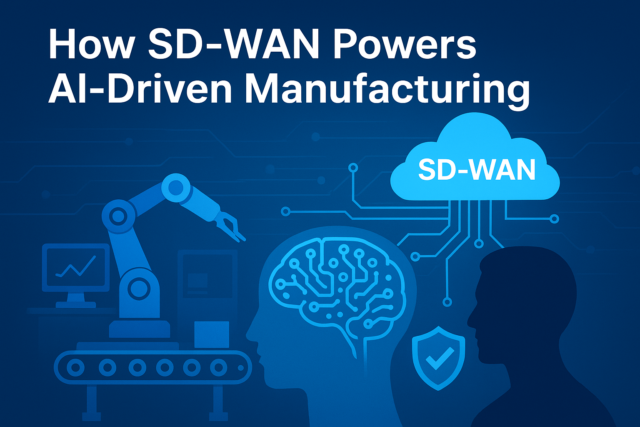The Unexpected Evolution of SD-WAN
The rise of AI is reshaping manufacturing – from smart assembly lines and predictive maintenance to real-time quality control. These AI-driven processes generate massive, unpredictable data flows that strain traditional networks. Manufacturers need connectivity that can keep pace: high-bandwidth links, ultra-low latency, and flexible, distributed architecture. Fortunately, modern SD‑WAN (software-defined WAN) is evolving to meet these needs. Once designed simply to connect branch offices, SD‑WAN today offers intelligent traffic management, security, and cloud/edge integration that can carry the load of AI manufacturing workloads. In this article we explore the challenges AI places on factory networks and how SD-WAN managed services – especially co‑managed or fully managed solutions – help manufacturers upgrade intelligently for the AI era.
AI-Driven Manufacturing: New Network Demands
AI applications in manufacturing are transforming operations, but they demand much more from networks than traditional IT. For example, computer vision on production lines or machine learning models for robotics send high-resolution sensor data upstream and expect rapid responses. This creates upload-heavy, bursty traffic: unlike normal web browsing (which is ~90% download), AI interactions often push large files to the cloud and receive concise replies. In practice, video/audio feeds and camera images (used for defect detection, automation, etc.) flood out of factories for processing, and results stream back in short bursts. Network architects note that “upload speeds on wireless networks can be 10× slower than download speeds” – and that must change to support AI.
At the same time, AI workloads are latency-sensitive. Training or inference often happens in parallel across the factory and cloud. Any delay can derail complex calculations. As EMA analysts explain, large language models run centrally but rely on inputs from many small models at the edge; high latency “delays or breaks distributed AI application processing, leading to unreliable inferences”. In short, factories need networks with symmetric high bandwidth and ultra-low latency. According to recent research, “AI workloads need high-bandwidth connectivity in both directions” and have “low tolerance for delayed uploads”.
Key network challenges for AI-enabled manufacturing include:
-
Unpredictable, bursty traffic: AI tasks generate sporadic large data transfers (e.g. an anomaly detected on the line triggers massive file uploads). Networks must handle these sudden spikes without congestion or loss.
-
High-volume uplink use: Unlike conventional WANs optimized for downloads, AI inverts the flow. Factories continuously upload camera feeds, sensor logs and design data to cloud AI platforms. Legacy WAN links and broadband often lack sufficient upstream capacity.
-
Stringent latency/jitter requirements: Even small delays can impact real-time control and analytics. For example, milliseconds matter when coordinating automated robots or enforcing just-in-time production across a global supply chains.
-
Distributed and peer-to-peer communication: AI tasks often run on edge devices, local clusters, and cloud in tandem. Instead of simple hub-and-spoke, endpoints (factories, warehouses, labs) frequently talk directly to each other and to edge servers. This “peer-to-peer” traffic pattern is far more complex than traditional office-centric traffic.
-
Stringent security and compliance: Manufacturing IP and production data are highly sensitive. AI demands encrypting massive files in motion and protecting edge devices from threats – requirements beyond what older WANs typically provide.
These factors combine to overwhelm static WAN architectures. In fact, industry experts warn that AI is imposing “constraints that traditional networks were not designed to accommodate”. In one study, 43% of enterprises plan network upgrades specifically because of AI demands. For manufacturers, the impact is clear: connectivity must scale with data, support dynamic traffic patterns, and extend security everywhere, or otherwise AI investments will hit a performance wall.
Why Traditional WANs Fall Short
Legacy WAN designs – typically MPLS backbones or simple broadband – struggle with these needs. They often provide fixed bandwidth and are optimized for predictable, asymmetric flows (more download than upload). As one analyst puts it: “networks are built today to facilitate data coming in the other direction”. In practice, many factory sites have high-speed fiber downstream but significantly lower upstream capacity. With AI, the imbalance can choke operations.
Moreover, conventional WANs are usually centrally orchestrated: remote sites send data to a headquarters data centre or cloud, and back again. However, AI-driven manufacturing is inherently distributed. Real-time machine-to-machine communication, collaboration across factories, and edge analytics all demand peer-to-peer connectivity. The research is emphatic: “The future of AI networking is peer-to-peer and distributed”. Factories need local data processing (edge compute) with seamless links to cloud AI and other plants. This hybrid, dynamic topology requires a fundamentally different approach.
Another shortfall of traditional WANs is agility. Scaling up to meet an unexpected AI-driven demand (for instance, a sudden need for a new data link to a partner) typically means manual provisioning – “picking up a phone, calling an IT manager, and waiting for weeks”. In contrast, manufacturers today want the elasticity of cloud-style networking: instant, API-driven connections on demand. Without this flexibility, factories cannot react quickly to new production lines or global disruptions.
Finally, security integration is often limited. Many factory networks add disparate firewalls or IPS appliances, but don’t have end-to-end encryption or unified threat monitoring. With AI, data moves between numerous endpoints (cameras, sensors, cloud, central servers). Analysts caution that “network security must scale” for AI, securing every peer-to-peer tunnel and endpoint. Legacy WANs typically lack this integrated, automated security posture, exposing manufacturers to risk.
In summary, AI-driven manufacturing stretches the old WAN model on all fronts: traffic profile, topology, speed of change and security. This gap is why modern SD-WAN – with its software control and cloud-like agility – is now emerging as the cure for next-gen industrial networking.
How SD-WAN Evolves for AI Workloads
SD‑WAN was born to simplify branch connectivity; today it is evolving as a powerful platform for AI networks. By decoupling the control plane from hardware, SD‑WAN overlays give unprecedented flexibility. Leading SD‑WAN vendors are now embedding AI/ML throughout their platforms to meet AI’s unique needs. For manufacturers, this translates into networks that can learn, adapt and self-optimise for heavy AI workloads.
Key ways modern SD-WAN supports AI-driven manufacturing include:
-
Dynamic Traffic Steering: SD-WAN continuously monitors link performance and application requirements, then directs each flow over the best path. For instance, an AI training upload from a factory can be automatically steered to a high-bandwidth 5G or LTE backup link if the primary connection congests. This per-flow agility ensures critical AI traffic (like real-time control data) gets precedence, even amid bursts.
-
Burst and Latency Management: As noted, GenAI workloads arrive in burs
-
ts. AI-enhanced SD-WAN (e.g. VeloCloud with VeloRAIN architecture) is explicitly designed to handle this. Its algorithms detect AI application signatures and instantly allocate extra bandwidth or faster paths when needed. Such AI-powered traffic slicing maintains low latency and throughput during spikes. In practice, an SD-WAN can pre-emptively reserve capacity for training jobs, or throttle less critical traffic during AI inference, smoothing the bursts.
-
Application Awareness: Next-gen SD-WAN can identify AI application types and even specific AI models by their network behavior. This means the network “knows” when a video stream is being used for vision analytics or when an LLM is processing factory data. It can then automatically apply the right policy (e.g. assign priority or QoS). For manufacturers, that avoids manual policy tuning: the SD-WAN controller ensures optimal paths for robot-control traffic one moment and factory audit streams the next.
-
Edge Integration: SD-WAN seamlessly ties together cloud, data center and on-site edge devices. In smart factories, many AI workloads run on local “factory-edge” servers or industrial PCs. SD-WAN supports this by establishing secure links from each edge node back to AI clouds and even directly between edge nodes. Combined with edge compute, this cuts round-trip latency. As one industry guide notes, “edge computing brings data processing closer to where it’s needed, reducing latency and improving response times for critical manufacturing applications”. SD-WAN simplifies connecting those edge nodes as just another site in the overlay network.
-
AIOps and Automation: By embedding AI/ML, SD-WAN systems gain self-healing and optimization capabilities. Gartner notes that within a few years, most network teams will use AI to manage SD-WAN. In practice, an AI-native SD-WAN can detect anomalies, predict congestion, and even automatically tweak policies. For example, if a routing loop or sudden failure emerges, the SD-WAN’s AI-powered orchestrator could reroute flows or spin up a backup circuit without human intervention. This speeds issue resolution and “reduces operating expenditures (opex) – a valuable benefit for lean manufacturing IT teams.
Collectively, these enhancements mean SD-WAN becomes an agile, secure backbone tailored for AI. As one analyst put it, SD-WAN now allows enterprises to “manage distributed AI workloads efficiently, prioritize mission-critical AI applications, and ensure seamless connectivity across cloud, edge and on-premises environments”. The same principles apply to factories: diverse shop-floor devices and cloud ML systems are all networked under one intelligent control domain.
Finally, modern SD-WAN integrates security. It can encrypt every tunnel and segment traffic to prevent lateral breaches. Leading solutions layer SASE (Secure Access Service Edge) services such as cloud firewalls, intrusion prevention and data-loss protection onto the SD-WAN fabric. This means AI data (often sensitive process or design info) stays protected end-to-end. Manufacturers benefit from unified security policies across the globe – from the plant floor to suppliers – enforced by the SD-WAN platform.
Connecting Factories Globally: SD-WAN Use Cases
Real-world deployments underscore how SD-WAN is enabling AI in manufacturing:
-
Global Performance and Scale: Manufacturers often coordinate plants across continents. SD-WAN makes it easier to scale bandwidth worldwide. For instance, a leading connectivity provider notes that manufacturing customers bought “364% more capacity in 2024 than in 2020,” driven by smart factory needs. SD-WAN helps manage that complexity: new links (even in remote locations) can be added to the overlay quickly, and traffic is optimally routed internationally. Low-latency paths (via multiple carriers, 5G links, even satellite) can be stitched together so that “control systems can respond instantly to changing conditions” on the shopfloor.
-
Edge AI and 5G Adoption: Many factories are deploying private 5G and on-premise AI servers for real-time analytics. SD-WAN ties these elements into the corporate WAN. For example, an SD-WAN edge router can aggregate a 5G connection and Wi-Fi sensor network, combining them with wired links. The SD-WAN controller then ensures local AI applications (like defect detection cameras) always have the freshest data, either by processing on-site or streaming to a cloud service with minimal hops. The result: predictive maintenance data from machines, or AR/VR guidance for workers, flows smoothly despite the variety of connections.
-
IoT and Quality Control: High-resolution vision systems for quality inspection generate constant data. SD-WAN’s adaptive bandwidth allocation shines here. It can prioritise the traffic from a critical camera feed over, say, backup telemetry or a less time-sensitive application. This guarantees real-time quality analytics without clogging the WAN. A fiber link may carry most video, but if that link dips, the SD-WAN can seamlessly offload packets to an LTE line without dropping frames. These features let manufacturers preserve strict quality control SLAs even as image data loads surge.
-
Supply Chain Integration: Modern supply chains require real-time data exchange with partners (suppliers, logistics, distributors). SD-WAN overlays can extend securely to third parties via dedicated tunnels. For example, shipment tracking data from a distribution center can be routed through the SD-WAN to a partner’s network segment. By doing so, the manufacturer gains end-to-end visibility while maintaining control and security. In sum, SD-WAN helps create a “digitally connected” supply network, aligning with the Industry 4.0 vision of integrated operations.
These use cases demonstrate that SD-WAN is not just a branch-office tool anymore. It underpins the global, high-performance network fabric that AI-driven manufacturing demands.


